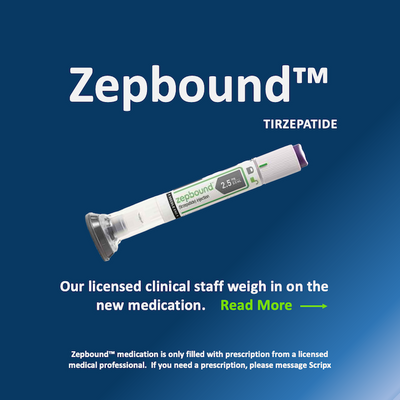Weight loss injections near me

Zepbound injection for weight loss if you struggle with stubborn weight that won’t budge. Imagine a solution that could revolutionize your weight loss journey. Enter Buy Zepbound injection, the latest medical weight management breakthrough impacting health and wellness.
Losing weight can feel like an uphill battle, leaving many frustrated and discouraged. But what if there was a way to give your body the extra push it needs? Zepbound injection offers a promising new approach to weight loss, combining cutting-edge science with practical application. This innovative treatment is not just another fad diet or quick fix. It’s a medically supervised intervention designed to help those who have struggled with traditional weight loss methods.
This comprehensive guide will explore everything you need about zepbound injection for weight loss. We’ll cover all the essential aspects of this groundbreaking treatment, from understanding how it works and where to inject it to comparing it with similar medications like Mounjaro. We’ll also explore its effectiveness, potential side effects, and important considerations before use. So, are you ready to discover if Zepbound weight loss could be the game-changer in your weight loss journey? Let’s dive in! 💉💪
What is Zepbound injection for weight loss?
Zepbound injection is a revolutionary injectable medication developed by Eli Lilly for weight loss in adults who are obese or overweight and have weight-related health conditions. Its active ingredient, tripeptide, mimics natural hormones to regulate appetite and food intake.
Key features of Zepbound injection for weight loss:
- FDA-approved for weight management
- Once-weekly subcutaneous injection
- Dual GIP and GLP-1 receptor agonist
- Suitable for adults with BMI ≥30 or ≥27 with weight-related comorbidities
| Aspect | Detail |
|---|---|
| Brand Name | Zepbound |
| Generic Name | Tirzepatide |
| Manufacturer | Eli Lilly |
| Primary Use | Weight Loss |
| Administration | Injectable |
How Does Zepbound Injection for Weight Loss Work?
Zepbound (tripeptide) functions as a dual GIP and GLP-1 receptor agonist, targeting key hormones in appetite regulation and glucose metabolism. This unique mechanism of action helps:
- Reduce hunger
- Increase feelings of fullness
- Slow gastric emptying
- Improve insulin sensitivity
| Receptor | Function |
|---|---|
| GIP | Enhances insulin response |
| GLP-1 | Reduces appetite and slows digestion |
By mimicking these hormones, Zepbound effectively supports weight loss efforts and improves glycemic control in individuals struggling with obesity or type 2 diabetes.
Where to inject Zepbound for best results?
Zepbound is typically injected under the skin (subcutaneously) in the abdomen, thigh, or upper arm. For best results, rotate injection sites within the same area each week. The abdomen is often preferred due to ease of access and consistent absorption. Always follow your healthcare provider’s instructions and the medication guide for proper injection technique.
Zepbound vs Mounjaro – what is the difference?
Zepbound vs Mounjaro – what is the difference?
Zepbound and Mounjaro are both injectable medications containing tirzepatide, developed by Eli Lilly. The key difference lies in their FDA-approved indications:
| Medication | FDA-Approved Indication |
|---|---|
| Zepbound | Weight loss |
| Mounjaro | Type 2 diabetes |
While both contain the same active ingredient, Zepbound is marketed explicitly for weight management, whereas Mounjaro is primarily used for blood sugar control in type 2 diabetes patients. However, weight loss is often observed as a beneficial side effect of Mounjaro treatment.
What are the side effects of Zepbound injection for weight loss?
Common Zepbound side effects
- Nausea
- Diarrhea
- Vomiting
- Constipation
- Abdominal pain
These side effects typically subside as your body adjusts to the medication. To minimize discomfort, start with a low dose and gradually increase it under your doctor’s guidance.
Serious Zepbound side effects
| Side Effect | Symptoms | Action |
|---|---|---|
| Pancreatitis | Severe abdominal pain, vomiting | Seek immediate medical attention |
| Gallbladder problems | Upper abdominal pain, fever | Contact your healthcare provider |
| Hypoglycemia | Dizziness, confusion, sweating | Monitor blood sugar levels closely |
While rare, these severe side effects require prompt medical attention. Always inform your doctor of any unusual symptoms during treatment.
Related/similar drugs
A. Mounjaro
Mounjaro, like Zepbound, contains tirzepatide and is used for type 2 diabetes and weight management. Both drugs work similarly by mimicking gut hormones.
| Drug | Active Ingredient | Primary Use |
|---|---|---|
| Mounjaro | Tirzepatide | Type 2 diabetes, weight loss |
| Zepbound | Tirzepatide | Weight loss |
B. Wegovy
Wegovy, which contains semaglutide, is another injectable medication for weight loss. It works by increasing feelings of fullness and reducing appetite, similar to Zepbound, but with a different active ingredient.
How much weight is lost on Zepbound?
Zepbound has shown impressive weight loss results in clinical trials. On average, patients using the highest dose (15 mg) lost about 22.5% of their initial body weight over 72 weeks. This translates to:
- 15 mg dose: 22.5% weight loss
- 10 mg dose: 21.4% weight loss
- 5 mg dose: 16% weight loss
| Dose | Average Weight Loss |
|---|---|
| 15 mg | 22.5% |
| 10 mg | 21.4% |
| 5 mg | 16% |
Individual results may vary, and weight loss should be combined with a healthy diet and exercise for optimal outcomes.
Warning
Important Precautions
- Consult your doctor before use
- Not for patients with certain medical conditions
- Potential risk of thyroid tumors
While Zepbound is effective for weight loss, it has essential warnings. Patients with a personal or family history of medullary thyroid carcinoma (MTC) or Multiple Endocrine Neoplasia syndrome type 2 (MEN 2) should avoid this medication. It’s crucial to discuss any pre-existing conditions with your healthcare provider before starting Zepbound treatment.
| Condition | Action |
|---|---|
| MTC history | Avoid use |
| MEN 2 | Avoid use |
| Pregnancy | Consult doctor |
Before using this medicine
A. Pregnancy
- Consult your doctor before using Zepbound if pregnant or planning a pregnancy
- Limited data on tirzepatide use during pregnancy
- Potential risks to fetus unknown; caution advised
| Trimester | Recommendation |
|---|---|
| First | Avoid use |
| Second | Consult doctor |
| Third | Consult doctor |
B. Breastfeeding
Zepbound’s safety during breastfeeding is not well-established. It’s unknown if tirzepatide passes into breast milk or affects milk production. Discuss with your healthcare provider to weigh potential benefits against risks. Alternative weight loss methods may be recommended for nursing mothers.
How should I use Zepbound?
Administering Zepbound injection for weight loss
Zepbound should be injected subcutaneously once weekly. Follow these steps:
- Choose the injection site (abdomen, thigh, or upper arm)
- Clean the area with alcohol
- Pinch the skin and insert the needle at a 90-degree angle
- Inject medication slowly
- Remove the needle and dispose of it properly
Dosage and Timing
| Starting Dose | Maintenance Dose | Injection Frequency |
|---|---|---|
| 2.5 mg | Up to 15 mg | Once weekly |
Administer Zepbound at the same time each week for consistency. If you miss a dose, take it as soon as possible, within 4 days. Otherwise, skip and resume your regular schedule.
Zepbound Dosing Information
Usual adult Zepbound dose for weight loss
Zepbound dosing typically starts at 2.5 mg once weekly and gradually increases to 5 mg, 7.5 mg, 10 mg, 12.5 mg, and 15 mg. This escalation helps minimize gastrointestinal side effects. The recommended maintenance dose is 15 mg once weekly, administered via subcutaneous injection.
Usual adult Zepbound dose for obstructive sleep apnea
For obstructive sleep apnea, Zepbound dosing follows a similar pattern to weight loss treatment. The initial dose is 2.5 mg weekly, increasing gradually to the target dose of 15 mg weekly. Dose adjustments may be necessary based on individual patient response and tolerability.
| Dose Level | Weeks | Weekly Dose |
|---|---|---|
| Initial | 1-4 | 2.5 mg |
| Step 1 | 5-8 | 5 mg |
| Step 2 | 9-12 | 7.5 mg |
| Step 3 | 13-16 | 10 mg |
| Step 4 | 17-20 | 12.5 mg |
| Maintenance | 21+ | 15 mg |
Zepbound Products
Zepbound is available in five different dosage strengths, each designed to meet specific patient needs:
- 2.5 mg/0.5 mL
- 5 mg/0.5 mL
- 7.5 mg/0.5 mL
- 10 mg/0.5 mL
- 12.5 mg/0.5 mL
15 mg/0.5 mL
| Dosage Strength | Pen Color | Recommended Use |
|---|---|---|
| 2.5 mg/0.5 mL | Light Gray | Starting dose |
| 5 mg/0.5 mL | Orange | Maintenance |
| 7.5 mg/0.5 mL | Olive | Maintenance |
| 10 mg/0.5 mL | Blue | Maintenance |
| 12.5 mg/0.5 mL | Pink | Maximum dose |
| 15 mg/0.5 mL | Purple | Maximum dose |
What should I do if I miss a dose?
What to Do if You Miss a Dose
If you miss a dose of Zepbound, follow these guidelines:
- Within 4 days: Take the missed dose as soon as you remember
- After 4 days: Skip the missed dose and resume your regular schedule
- Never double dose: Don’t take two doses to make up for a missed one
| Time Since Missed Dose | Action |
|---|---|
| Within 4 days | Take it |
| After 4 days | Skip it |
Always consult your healthcare provider if you’re unsure about missed doses or have concerns about your Zepbound treatment schedule.
What should I do in case of an overdose?
What to Do in Case of an Overdose
In the event of a Zepbound overdose, immediate medical attention is crucial. Contact your local poison control centre or emergency services right away. Symptoms of overdose may include:
- Severe nausea and vomiting
- Extreme dizziness
- Rapid heartbeat
- Low blood sugar
| Action | Contact Information |
|---|---|
| Poison Control | 1-800-222-1222 |
| Emergency Services | 911 |
What is the cost of Zepbound?
Zepbound coupons, savings cards, or cost
Zepbound’s cost can be significant, but there are ways to make it more affordable. Here’s a breakdown of pricing and savings options:
| Option | Description |
|---|---|
| List price | ~$1,000 per month |
| Insurance coverage | Varies by plan |
| Manufacturer savings card | Up to $25/month for eligible patients |
- Check with your insurance provider for coverage details
- Visit Zepbound’s official website for current savings programs
- Consider patient assistance programs if you’re uninsured or underinsured
Interactions
Interactions
A. Does Zepbound interact with my other drugs?
Zepbound (tirzepatide) may interact with certain medications, potentially affecting their efficacy or increasing side effects. Common interactions include:
- Insulin and sulfonylureas
- GLP-1 receptor agonists
- Oral medications
| Drug Class | Potential Interaction |
|---|---|
| Insulin | Increased hypoglycemia risk |
| Sulfonylureas | Enhanced blood sugar lowering |
| Oral medications | Delayed absorption |
Always consult your healthcare provider about potential drug interactions before starting Zepbound. They can adjust dosages or recommend alternative treatments to ensure safe and effective weight management.
Storage
Storage Guidelines
Temperature and Light
- Store Zepbound at 36°F to 46°F (2°C to 8°C)
- Keep in original carton to protect from light
- Do not freeze or use if frozen
Travel and Room Temperature
| Condition | Maximum Time |
|---|---|
| Room temp | Up to 21 days |
| Travel | 12 hours at ≤86°F (30°C) |
Proper storage of Zepbound is crucial for maintaining its effectiveness. Always follow the manufacturer’s instructions and consult your healthcare provider or pharmacist if you have any questions about storing your medication. Remember to check the expiration date before use and dispose of expired medication safely.
Ingredients
Active Ingredient
Zepbound’s primary active ingredient is tirzepatide, a novel GIP and GLP-1 receptor agonist. This compound is responsible for the medication’s weight loss effects.
Inactive Ingredients
| Ingredient | Purpose |
|---|---|
| Water | Solvent |
| Sodium chloride | Tonicity agent |
| Sodium phosphate | pH buffer |
| Dibasic sodium phosphate | pH buffer |
Zepbound also contains trace amounts of inactive ingredients to maintain stability and pH balance. These components ensure proper absorption and effectiveness of the medication.
Zepbound Eli Lilly Company
Eli Lilly: Pioneering Zepbound
Eli Lilly, a global pharmaceutical leader, developed Zepbound (tirzepatide) for weight management. With a history of innovation, Lilly continues to address pressing health challenges. Their commitment to research has positioned Zepbound as a promising solution in the fight against obesity.
| Eli Lilly’s Contributions | Impact |
|---|---|
| Zepbound Development | Innovative weight loss solution |
| Clinical Trials | Demonstrated efficacy and safety |
| FDA Approval | Validated for medical use |
| Manufacturing | Ensuring quality and availability |
Popular FAQ
Common Questions about Zepbound
- Is Zepbound covered by insurance?
- How long does it take to see results?
- Can I drink alcohol while using Zepbound?
| Question | Answer |
|---|---|
| How often is Zepbound injected? | Once weekly |
| Is Zepbound suitable for everyone? | No, consult your doctor. |
Zepbound’s effectiveness and safety are common concerns. Many patients wonder about insurance coverage, timeline for results, and lifestyle adjustments. Discussing these questions with a healthcare provider for personalized advice is crucial. Remember, individual experiences may vary.
References
- Jastreboff, A. M., et al. (2022). Tirzepatide Once Weekly for the Treatment of Obesity. New England Journal of Medicine, 387(3), 205-216.
- FDA. (2023). FDA Approves New Medication for Chronic Weight Management. U.S. Food and Drug Administration.
| Study | Participants | Weight Loss |
|---|---|---|
| SURMOUNT-1 | 2,539 adults | Up to 22.5% |
| SURMOUNT-2 | 938 adults | Up to 21.4% |
- Eli Lilly and Company. (2023). Zepbound™ (tirzepatide) Prescribing Information.
- American Diabetes Association. (2023). Standards of Medical Care in Diabetes—2023.
More about Zepbound (tirzepatide)
Patient resources
- Online support groups
- Educational materials
- Medication tracking apps
| Resource Type | Description |
|---|---|
| Support Groups | Connect with others using Zepbound |
| Educational Materials | Learn about proper usage and expectations |
| Tracking Apps | Monitor progress and manage dosages |
Professional resources
Healthcare providers can access clinical guidelines, dosing information, and potential drug interactions through Eli Lilly’s professional portal. This comprehensive resource ensures medical professionals can make informed decisions when prescribing Zepbound for weight loss treatment.
Further information
Additional Resources
Ongoing Research
| Study Focus | Expected Completion |
|---|---|
| Long-term efficacy | 2025 |
| Cardiovascular outcomes | 2026 |
| Combination therapies | 2024 |
For the latest updates on Zepbound, consult your healthcare provider or visit reputable medical journals. Stay informed about new developments in weight loss treatments to make the best decisions for your health.
Zepbound injection offers a promising solution for individuals struggling with weight loss. This comprehensive guide has explored various aspects of Zepbound, from its mechanism of action to proper usage, potential side effects, and comparisons with similar medications. By understanding the intricacies of this treatment, patients can make informed decisions about their weight management journey.
As with any medical intervention, it’s crucial to consult with a healthcare professional before starting Zepbound. They can assess your individual needs, potential risks, and determine if this treatment is right for you. Remember, while Zepbound can be an effective tool for weight loss, it should be used in conjunction with a healthy lifestyle, including proper diet and regular exercise, to achieve optimal results and maintain long-term health benefits.


